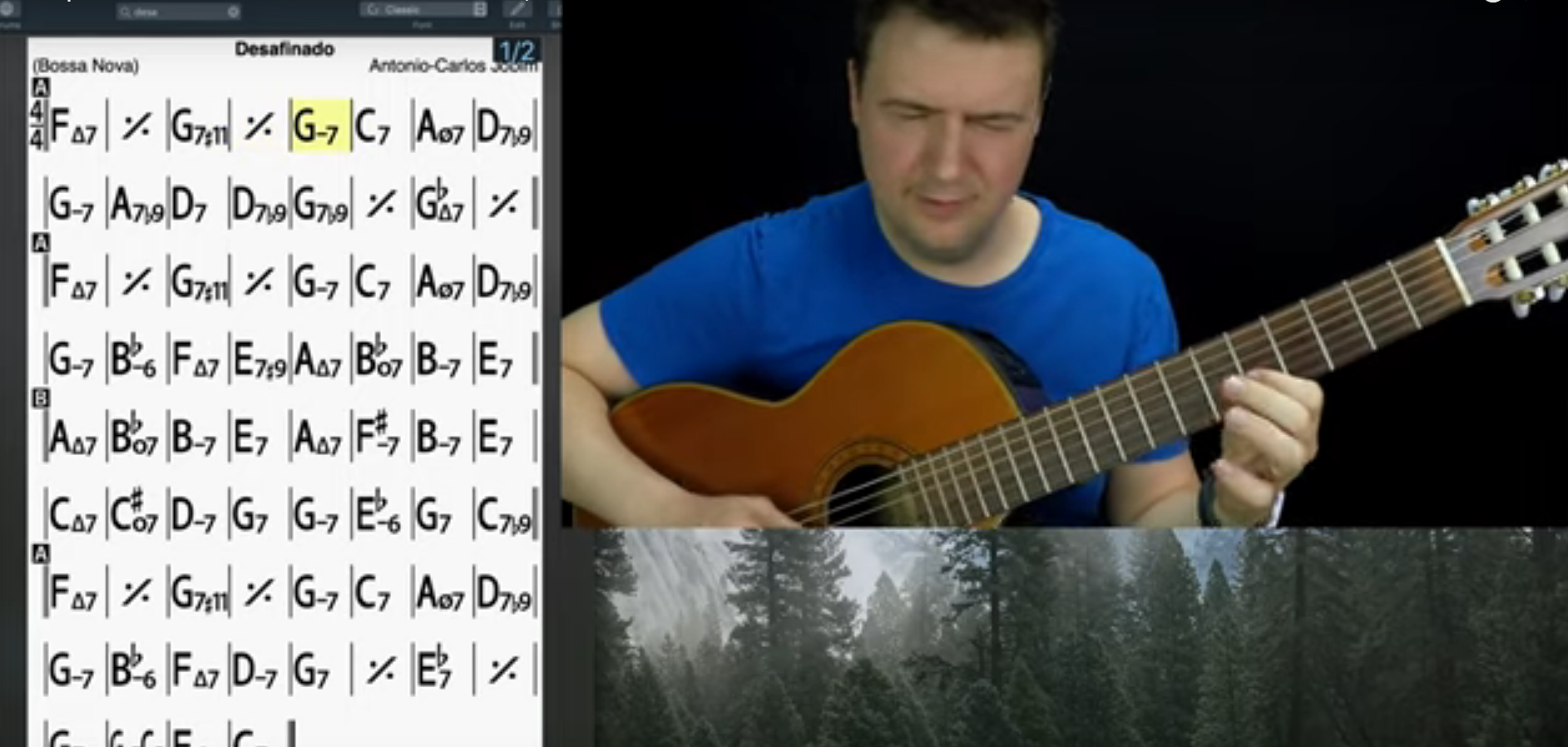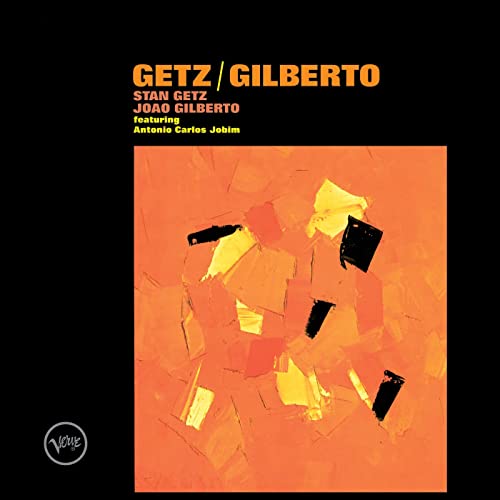
Jazz Improvisation on Bossa Novas and Brazilian Standards
Mar 24, 2021Bossa Novas and Brazilian tunes sound oh-so-good. Tunes written by Jobim are almost ubiquitous, with classics like "Girl from Ipanema" and "Desafinado" being favorites for jazzers and non-jazzers alike.
If you've ever tried to play one though, you might notice that they're a little different from the bebop or blues tunes you might be use to playing. They're highly melodic and harmonically dense and complex tunes -- pretty different from your C Jam Blues or Scrapple from the Apple.
And, it goes without saying that trying to approach these carefully crafted, majestic beasts of compositions in the same way that you approach simple 12-bar forms meant for blowing your fingers off with high-speed runs that are practically just the scales you play in the practice room just won't sound good.
This lesson we will be doing Bossa Nova motifs on these scales.
Scales:
F major
F G A Bb C D E
G lydian-dominant
G A B C# D E F G
So, how can you approach improvising on bossa novas and Brazilian tunes? We're here to give you the secret. Read on, jazzer!
Download your "Bossa & Brazilian Standards - Motif Improv" PDF here
Join our Community here.
In this blog post, we'll use the tune Desafinado as a template for demonstrating how to use motifs and patterns to sound tasteful and masterful when you improvise on bossa novas.
Playing scalar runs just won't sound the same, and with such melodic tunes, it only makes sense that your improvisation should be equally founded in melody.
We'll talk about how to do that with a few strategies and outline some exercises to work on for practice.
But before that, let's make sure we're familiar with the tune.
Suggested Listening Material
To get to know the tune, check out some of these recordings:
Quincy Jones' Big Band Bossa Nova
Get Your Full Desafinado Motif PDF!
Before starting, you can grab the PDF that will contain fully notated exercises discussed in this lesson, complete with guitar tabs. It covers everything we talk about here, and it's free! :)
Download your "Bossas & Brazilian Standards - Motif Improv" PDF here.
Part 1: Single Motif Through One Scale - 2:41
Part of playing from the melody is to literally play from the melody.
In this exercise, we'll pick a 4-note pattern from the melody. Let's say it's the very first phrase in the tune. It looks like this:

Now, we'll take that same phrase and run it through every scale degree in the scale that represents the current chord.
For example, the first chord in the tune is Fmaj7. So first we will play this phrase, starting on the first scale degree ( F ):

Then, we'll play the same phrase, starting on the next scale degree...

And so on until you've gone through every scale degree.
...That's a lot of work!
But, we're not done yet. Now, we can do the same thing on every change in the tune. It sounds tedious, but if you do this right, you will get a really good idea of how to take your motifs and ideas through the changes on any tune.
Of course, you can do this with any of the motifs or phrases from the melody. In fact, let's take the second phrase as an example now. We'll do the same thing, starting on F, through F major:

Now, same pattern starting on the second scale degree, G:
Realistically, you can do it with any motif that comes to mind, but picking a phrase from the melody will help you build vocabulary that is relevant to the tune.
And of course, if you want to practice this exercise, you can download the full PDF which includes the motifs covered here through the first two chord scales in the tune, with TABS, to get you started!
Download your "Bossa & Brazilian Standards - Motif Improv" PDF here
Join our Community here.
Now that we've covered how to to practice a single motif through one scale, we can move onto more advanced exercises.
Part 2: Single motif starting on absolute note - 11:30
For the next two exercises, try not to have any sort of safety net going into it! Just let the changes go by and do your best.
You can start the pattern on any note in the scale degree. Instead of changing the scale degree we start on though, we are going to play the motif starting on the same note every time there's a change.
For example, let's pick C this time, which is the 5th of the first chord in the tune (F major). You would play the first pattern like so (with slight variation no the rhythm):

When we change to the next chord, G7#11, we'll still begin the motif on C, but adjust the notes to fit the alterations in the scale.

Now, we'll do the very same thing... for every change in the tune! This is a laborious, but extremely thorough process. If you can do this, it will show that you know your scales really well. And if you don't, this is a great place to start.
Make sure to grab your PDF to practice here, because it has this exercise notated out for the above motif throughout the entire form of the tune.
Download your "Bossa & Brazilian Standards - Motif Improv" PDF here
Join our Community here.
We can even take things a step further...
Part 3: Single motif starting on relative note - 13:42
Expanding again from the last exercise, we can practice taking motifs through the form by playing them relative to the chords.
If we again start on C, which is the 5th of F major, on the next chord, we would instead start the pattern on Db, the (flat) 5th of G7b5.
It would look like this for the first four bars of the tune:

These types of exercises can be really exhausting, especially on a tune like this one because the form is so long! Take it slow because it will really make you think.
However, we've made it easy for you for this first motif, and notated everything out for the whole form in the PDF, which you can grab below if you haven't yet:
Download your "Bossa & Brazilian Standards - Motif Improv" PDF here
Join our Community here.
After you've made your way through one scale degree, you can start the motif on a different scale degree and do the same thing.
These exercises test your knowledge of scale and chord spellings in a lot of depth. If you're not up to it yet, you may want to hit the woodshed with the Definitive Guide to Scale Positions for Guitar.
This well help you learn the scale degrees of basic scales and get you ready to practice the exercises in this blog post!
Part 4: Putting it All Together; No Safety Net! - 15:45
This part comes after you've spent some time with the last two exercises. The goal here is to take the motif through the changes and play it starting on whatever scale degree, on any part of the fretboard, and fit the motif into the chord scale as the changes go by.
It's scary! Make sure to check out the video at the specified timestamp to see an example of how this looks and sounds.
Wind-Down: Backstory and Origin - 16:49
If you're wondering how these exercises came to be, they draw on age-old writing techniques that employ motivic development. Classical musicians like Mozart and Beethoven were doing this way back centuries ago!
Sometime about 8 years ago, I had a workshop with a guy named Gilad Hekselman, a 23-year old (at the time) player from Israel. He asked us to do these exercises with Stella by Starlight, and if you could do them, you were essentially extracting the juices from the tune instead of improvising by reinventing the wheel.
It's simply a great approach to avoid sounding like a fool on tunes where the bebop approach just isn't appropriate.
Full Improvisation Demonstration on Desafinado - 20:30
To hear what it sounds like to incorporate all of these techniques and ideas into your playing, check out the video at the timestamp above. Copy, copy, copy! Make sure you try this yourself and add in your own flair.

Closing Notes and Tips - Editor's Special ;)
If you've made it this far, congratulations! Although this blog post is on the shorter side for this type of video, it is jam packed with content to practice.
You can take these exercises and apply the same principles to any tune, and they work really well on Bossa Novas in particular. Playing from the melody is a cornerstone of improvisation and expanding your vocabulary.
If you can do all of these exercises with different motifs in the tune, by starting on whatever scale degree you want, or even make up your own motifs and do the same thing, you've mastered them.
You may have to think really hard at first about scales and alterations, but eventually your ear will guide you, and you will be able to do it without really thinking at all.
Thanks for checking out the blog, and see you next time!













